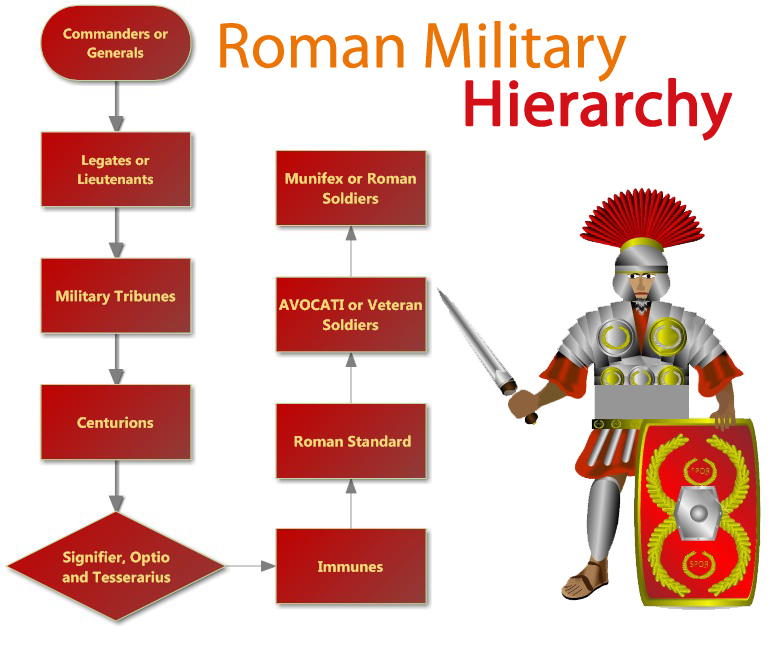The Roman army is the name given to the terrestrial armed forces of the kingdom of Rome. The hierarchical structure that the roman army represents today finds its roots in quite old eras. Roman army has always stayed popular due to its acts of braveries, the excellence of its soldiers and the structure in which it is arranged that is known as Roman military hierarchy. The basic roman military hierarchy followed by the roman armed forces is as follows:

The first rank in the roman military hierarchy is acquired by Commanders or Generals who are also known as Imperators or Dux. This term refers to the senior most army men in the roman military hierarchy. Imperator is the special title given to specific commanders after a victorious battle had been hailed by their troops. The army men in this group enjoy the highest set of privileges and even serve the greatest responsibilities.
Legates or Lieutenants are the second rank holders in the roman military hierarchy who are responsible for commanding legions. The commandants at this position are in charge of a host of tasks.
Then in the roman military hierarchy are the Quaestors who are responsible for taking care of the military supplies and chest.
The next level in the roman military hierarchy is acquired by the Military Tribunes. These officers are responsible for taking care of legion along with five other officers of the similar grade. One of all these six officers takes the responsibility of managing all tasks and the rest five officers. But that depends on internal criteria of selection and has nothing to do with ranks.
Centurions comprise the next level in the roman military hierarchy. These are responsible for the whole supervision and care of an individual Centuria, that is, a command of 100 soldiers. These professionals are assisted by their subordinate officers refereed as Signifier, Optio and Tesserarius. These professionals are one of the high rank professionals in the army and enjoy much higher remuneration & status than the other officers placed below them.
Immunes are the professionals who stand below the centurions in the roman military hierarchy. These are the soldiers who possess some special skills. These professionals are the specialists who get basic remuneration and enjoy immunity from most of the fatigue duties. Although this is not a very higher rank but these professionals are given respect of because of their special skills.
The next rank is of the Roman Standard who are the army officers led by the centurions. This is a junior officer rank and these professionals report directly to their centurions. These professionals are required to perform various duties that include them to act as rallying points, key symbols of roman power and honor and as recognition signals to recognize the individual units in the battle.
The next rank is the AVOCATI or Veteran Soldiers. These are the soldiers who possess special skills which are served against the nonstandard service conditions. These are also referred as one of the non-commissioned rank officer.
The next rank is the Munifex or Roman Soldiers. This is the lowest rank in the army which is equivalent to the privates. These professionals get the basic remuneration and also perform the fatigue duties.
